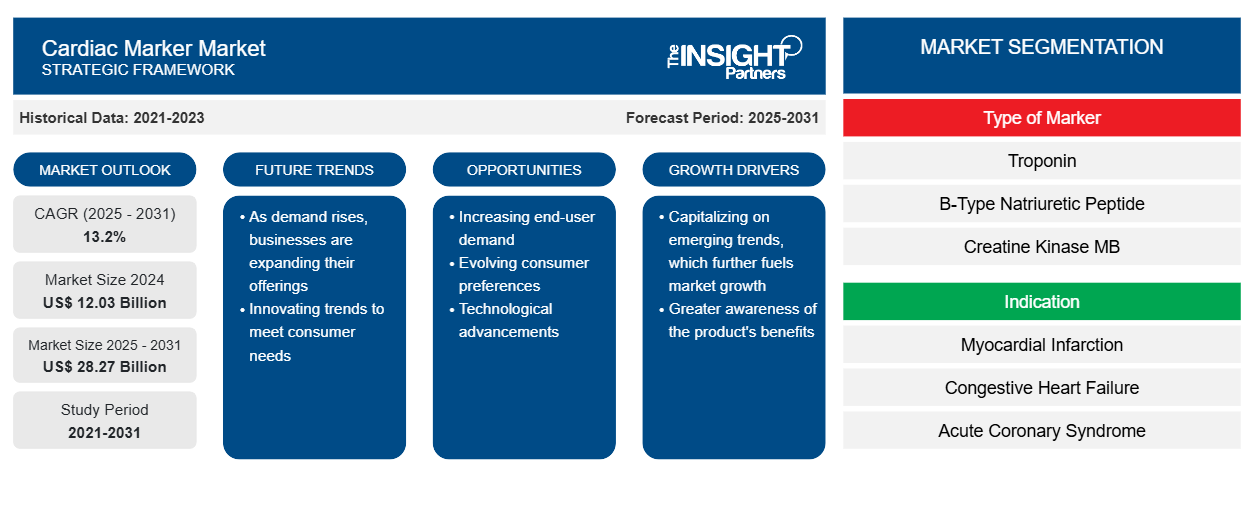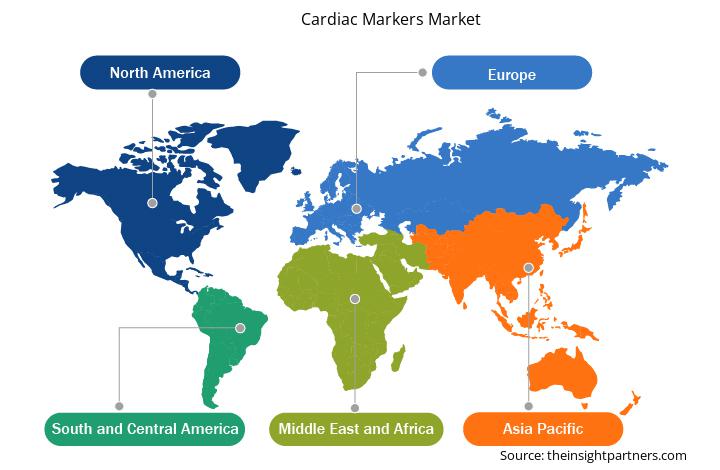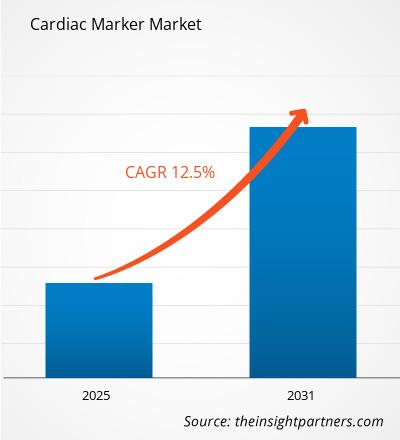[研究报告] 心脏标志物市场规模预计将从 2024 年的 120.3 亿美元增长到 2031 年的 282.7 亿美元;预计 2025-2031 年期间的复合年增长率为 13.2%。
市场洞察和分析师观点:
心脏标志物是心肌受损或受压时释放到血液中的物质。这些标志物用于识别和监测各种心脏疾病。这些标志物通过血液检测进行测量,其水平可以提供有关心脏功能的重要信息。心脏标志物对于各种疾病(例如急性冠状动脉综合征)的及时准确诊断和治疗以及预后评估至关重要。随着全球人口老龄化和心血管疾病(CVD)发病率的上升,对高灵敏度和特异性的心脏标志物检测的需求日益增长,以促进早期诊断和风险评估。此外,将人工智能(AI)和机器学习算法融入心脏标志物分析,可以提高预测准确性并实现个性化治疗方案。心脏生物标志物领域的技术进步为心脏生物标志物行业带来了丰厚的机遇。
增长动力:
根据世界卫生组织 (WHO) 的数据,心血管疾病 (CVD) 是全球发病率和死亡率的主要原因。心血管疾病包括冠心病、心脏病发作、心肌缺血等。由于吸烟、糖尿病、肥胖和生活方式改变等各种因素,全球心血管疾病的负担正在上升。与心血管疾病相关的其他风险因素包括高血压、高胆固醇和糖尿病。心脏病发作和中风通常是由脂肪沉积阻塞血管,干扰流向心脏或大脑的血液引起的。各种心血管疾病的患病率不断上升,促使人们需要改进诊断方法。
根据世界心脏联盟发布的报告,全球有超过5亿人患有心血管疾病,2021年导致2050万人死亡。世界卫生组织的数据显示,每年有1790万人死于心血管疾病,占全球死亡人数的32%。美国心脏协会的数据显示,美国几乎一半的成年人患有某种心血管疾病。美国每5例死亡病例中就有1例死于心血管疾病。预计到2035年,将有超过1.3亿人(占美国总人口的45.1%)患有某种心血管疾病。
据世界卫生组织统计,每年约有 3000 万人中风。根据美国疾病控制与预防中心 (CDC) 的数据,每 40 秒就有一名美国人心脏病发作。每年约有 805,000 名美国人心脏病发作,其中约 605,000 人是首次发作。根据“2021 年百万心脏”项目的数据,美国每年约有 150 万人心脏病发作(心肌梗死)和中风。根据 CDC 2022 年的估计,2010 万美国成年人患有冠状动脉疾病。此外,欧洲心脏病学会报告称,患有心房颤动的患者患中风的风险要高出五倍,全国 20% 至 30% 的中风病例是由心房颤动引起的。
心血管疾病发病率的上升使得准确及时的诊断成为必要。预先监测和预先诊断可以预防大多数类型的心血管疾病。生物标志物是指在特定心血管疾病发作时释放到血液中的某些内源性物质,这些物质提示心脏功能异常。因此,使用心脏标志物有助于个人检测心血管异常。因此,预测期内,心血管疾病发病率的上升将推动心脏标志物市场的增长。
您可以免费定制任何报告,包括本报告的部分内容、国家级分析、Excel 数据包,以及为初创企业和大学提供优惠和折扣
心脏标志物市场:战略洞察

- 获取此报告的顶级关键市场趋势。此免费样品将包括数据分析,从市场趋势到估计和预测。
报告细分和范围:
全球心脏标志物市场根据标志物类型、适应症、最终用户和地理位置进行细分。根据标志物的类型,市场分为肌钙蛋白、B 型利钠肽、肌酸激酶 MB、肌红蛋白等。根据适应症,市场分为充血性心力衰竭、心肌梗死、急性冠状动脉综合征等。就最终用户而言,心脏标志物市场分为医院、诊断实验室、即时检验机构等。根据地域,心脏标志物市场分为北美(美国、加拿大和墨西哥)、欧洲(德国、法国、意大利、英国、西班牙和欧洲其他地区)、亚太地区(澳大利亚、中国、日本、印度、韩国和亚太其他地区)、中东和非洲(南非、沙特阿拉伯、阿联酋和中东和非洲其他地区)以及南美洲和中美洲(巴西、阿根廷和南美洲和中美洲其他地区)。
节段分析:
按标志物类型,心脏标志物市场分为肌钙蛋白、B 型利钠肽、肌酸激酶 MB、肌红蛋白等。2022 年,肌钙蛋白占据了相当大的市场份额。肌钙蛋白是心肌和骨骼肌收缩所需的蛋白质。心肌肌钙蛋白测试测量血液中肌钙蛋白 T (TnT) 或肌钙蛋白 I (TnI) 的水平。这些蛋白质仅在心肌受损(例如心脏病发作时)时才会出现在血液中。心肌肌钙蛋白测试可检测心肌损伤。心肌损伤越严重,血液中的肌钙蛋白水平就越高。心肌肌钙蛋白是迄今为止最常用的生物标志物,具有已知的最高灵敏度。肌钙蛋白是诊断和管理心血管疾病 (CVD) 的重大进步。当心肌细胞受到损伤时,这些高度特化的蛋白质会被释放到血液中。肌钙蛋白生物标志物对于诊断心脏病、评估心脏事件的严重程度、指导选择适当的治疗方案以及预测患者预后至关重要。此外,通过检测血液中的肌钙蛋白微量,高敏肌钙蛋白检测进一步提高了早期诊断心脏异常的能力,即使在没有临床症状的情况下也能诊断。
根据适应症,心脏标志物市场细分为心肌梗死、充血性心力衰竭、急性冠状动脉综合征等。由于与高收入国家相比,中低收入国家的疾病负担不断加重,急性冠状动脉综合征细分市场在 2022 年占据了相当大的市场份额。久坐工作增加和快速城市化等因素正在推高疾病发病率。心肌肌钙蛋白 T 和 I 生物标志物检测已成为疾病诊断的主要诊断方法。Cardio Diagnostics 于 2023 年 2 月推出了 PrecisionCHD,这是一种用于早期识别冠心病的综合表观遗传-遗传血液检测。该检测利用机器学习模型分析基因组和表观基因组数据以及遗传生物标志物和表观遗传学。它将患者的生物标志物概况与可改变的冠心病重要风险因素联系起来,包括吸烟、糖尿病、高血压和高胆固醇。然而,预计心肌梗死领域将在 2022 年至 2031 年期间实现市场最快的复合年增长率。
根据最终用户,心脏标志物市场可分为医院、诊断实验室、即时检验机构和其他。2022年,医院占据了相当大的市场份额。由于患者人流量大且拥有先进的诊断设施,医院占据了最大的份额。从急诊科到住院治疗,心脏生物标志物对于诊断急性心血管事件、识别患者风险以及指导治疗决策都至关重要。这些生物标志物的存在和准确的解读使医疗保健专业人员能够及时干预并改善患者预后。
区域分析:
根据地域划分,心脏标志物市场主要分为北美、欧洲、亚太地区、南美和中美以及中东和非洲。2022年,北美占据了全球市场的显著份额。北美心脏标志物市场的增长归因于心脏病(包括心血管疾病)发病率的上升、心血管疾病诊断研发支出的增加以及发达的医疗保健基础设施。2022年,美国占据了该地区最大的市场份额。
根据《2022 年心脏病和中风统计情况说明书》,预计每 40 秒美国就会有一人患心肌梗塞。同样,美国疾病控制与预防中心 2021 年 9 月的报告指出,美国 40 岁及以上人群中约有 650 万人患有外周动脉疾病。根据美国心脏协会的数据,美国每 34 秒就有一人死于心血管疾病。2021 年,美国有近 69.7 万人死于心脏病,即每五人中就有一人死于心脏病。此外,根据加拿大心脏和中风基金会 2022 年 2 月的报告,加拿大约有 75 万人患有心力衰竭,每年有 10 万人被诊断出患有心力衰竭。同样,根据美国国家卫生统计中心的数据,2023 年 2 月,美国 2021 年约有 695,000 人死于心脏病。美国每年约有 150 万人发生心脏病发作和中风。
美国心血管疾病(CVD)发病率的上升归因于高血压、高胆固醇、低高密度脂蛋白胆固醇、肥胖、糖尿病、腹型肥胖和吸烟等风险因素的日益普遍。心脏病每年给美国造成约2190亿美元的经济损失。这笔总费用包括医疗保健服务、药物和过早死亡的费用。
此外,该地区越来越多的市场参与者积极引入创新且技术先进的心脏标志物检测和设备,预计将促进市场增长。2021年7月,贝克曼库尔特与Quidel公司签署最终协议,收购其用于治疗充血性心力衰竭的贝克曼库尔特分析仪的BNP检测试剂的制造、分销和销售相关的所有权利。因此,上述因素预计将促进该地区市场的增长。
行业发展和未来机遇:
- 2021年7月,贝克曼库尔特与Quidel公司达成最终协议,获得贝克曼库尔特分析仪BNP检测试剂的生产、分销和销售相关的所有权利。根据协议条款,Quidel将继续生产并向贝克曼库尔特供应与该检测试剂相关的某些组件。贝克曼库尔特将以Access BNP品牌独家生产并向客户销售BNP检测试剂。
- 2021年4月,罗氏公司(F. Hoffmann-La Roche)推出了一系列五款全新应用,将其关键心脏生物标志物(cTnT-hs)与其Elecsys技术相结合。这些生物标志物已被证明可有效管理心血管疾病(CVD),并可帮助临床医生诊断心脏病发作并管理患者的心力衰竭。这提高了风险识别和诊断水平,并使公司能够从现有产品中获得更高的收入。
竞争格局和重点公司:
心脏生物标志物市场的一些知名参与者包括雅培诊断、罗氏诊断、生物梅里埃公司、赛默飞世尔科技公司、贝克曼库尔特公司(丹纳赫)、Bio-Rad Laboratories、Trinity Biotech Plc、Creative Diagnostics、Diazyme Laboratories, Inc、西门子股份公司和 Quidel Corporation。这些公司专注于推出新的高科技产品、改进现有产品并进行地域扩张,以满足全球不断增长的消费者需求。心脏生物标志物市场公司强调各种增长战略,例如合作、产品发布、业务扩展和协议等,以保持其在全球市场中的地位并增加其专业产品组合中的产品范围。他们拥有广泛的全球影响力,这使得他们能够服务于大量客户,从而增加其心脏标志物市场份额。
报告范围
心脏标志物市场区域洞察
Insight Partners 的分析师已详尽阐述了预测期内影响心脏标志物市场的区域趋势和因素。本节还讨论了北美、欧洲、亚太地区、中东和非洲以及南美和中美洲的心脏标志物市场细分和地域分布。

- 获取心脏标志物市场的区域特定数据
心脏标志物市场报告范围
| 报告属性 | 细节 |
|---|---|
| 2024年的市场规模 | 120.3亿美元 |
| 2031年的市场规模 | 282.7亿美元 |
| 全球复合年增长率(2025-2031) | 13.2% |
| 史料 | 2021-2023 |
| 预测期 | 2025-2031 |
| 涵盖的领域 | 按标记类型
|
| 覆盖地区和国家 | 北美
|
| 市场领导者和主要公司简介 |
|
心脏标志物市场参与者密度:了解其对业务动态的影响
心脏标志物市场正在快速增长,这得益于终端用户需求的不断增长,而这些需求的驱动因素包括消费者偏好的转变、技术进步以及对产品优势的认知度的提升。随着需求的增长,企业正在扩展产品线,不断创新以满足消费者需求,并抓住新兴趋势,从而进一步推动市场增长。
市场参与者密度是指特定市场或行业内企业或公司的分布情况。它表明特定市场空间内竞争对手(市场参与者)的数量相对于其规模或总市值而言。
在心脏标志物市场运营的主要公司有:
- 雅培诊断
- 罗氏诊断
- 生物梅里埃公司
- 赛默飞世尔科技公司
- 贝克曼库尔特公司(丹纳赫)
- Bio-Rad实验室
免责声明:以上列出的公司没有按照任何特定顺序排列。

- 获取心脏标志物市场顶级关键参与者概览
- 历史分析(2 年)、基准年、预测(7 年)及复合年增长率
- PEST和SWOT分析
- 市场规模、价值/数量 - 全球、区域、国家
- 行业和竞争格局
- Excel 数据集
近期报告
客户评价
购买理由
- 明智的决策
- 了解市场动态
- 竞争分析
- 客户洞察
- 市场预测
- 风险规避
- 战略规划
- 投资论证
- 识别新兴市场
- 优化营销策略
- 提升运营效率
- 顺应监管趋势






















 获取免费样品 - 心脏标志物市场
获取免费样品 - 心脏标志物市场